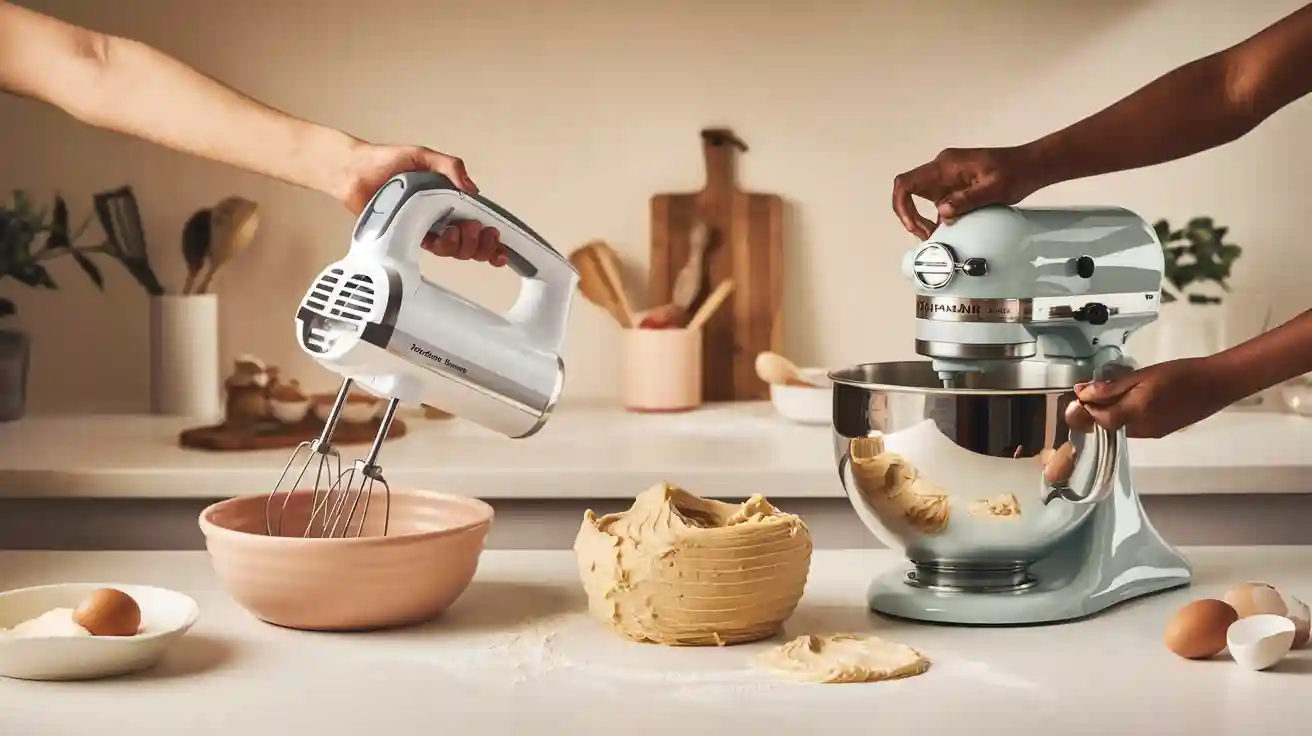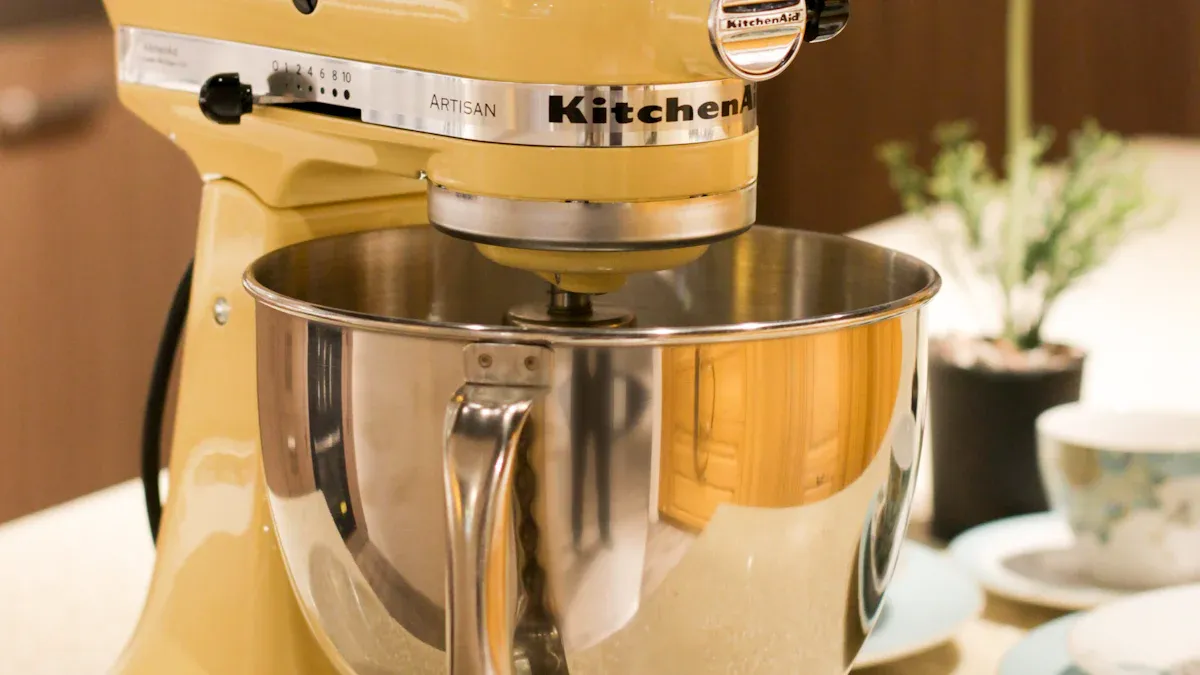
You want the right tool for your kitchen. Electric hand food mixers handle quick jobs and fit small spaces. Stand mixers work better for heavy dough and large batches. Prices vary, with hand mixer options costing less than stand mixers, which range from $110 to $700 for popular kitchen models:
| Mixer Type | Example Model | Price Range (USD) |
|---|---|---|
| Budget | Costway Stand Mixer | Around $110 |
| Mid-range | Hamilton Beach All-Metal Stand Mixer | Around $163 |
| Popular Mid-range | KitchenAid Artisan Series | $363 – $479 |
| High-end | Wolf Gourmet High Performance Mixer | Up to $700 |
Choose an electric hand mixer or a stand mixer based on your kitchen needs.
Quick Comparison Table: Electric Hand Food Mixers vs. Stand Mixers
Key Differences
When you compare a hand mixer to a stand mixer, you notice several important differences. A hand mixer is lighter and easier to move. Most hand mixers have motors between 220 and 400 watts. This makes them great for quick tasks like whipping cream or mixing cake batter. Stand mixers, on the other hand, have stronger motors—some reach up to 660 watts. They weigh more, often around 20 pounds, which helps them stay steady during heavy mixing jobs.
| Feature | Stand Mixer | Hand Mixer |
|---|---|---|
| Power | More powerful motors, good for heavy doughs and long mixing times | Less powerful, best for lighter, smaller batches |
| Batch Size | Handles large batches (up to 7-quart bowls) | Best for small to medium-sized batches |
| Speed Settings | Up to 10 speeds for more control | Usually 5 to 9 speeds |
| Versatility | Many attachments for different kitchen tasks | Limited to mixing, whisking, and beating |
| User Convenience | Hands-free operation, bowl stays in place | You must hold the mixer during use |
| Suitable Tasks | Heavy doughs, large batches, long mixing, specialty tasks | Quick mixing, whipping, small jobs |
| Portability & Storage | Large, needs countertop space | Compact, easy to store |
You can see how these differences affect performance in real tests. Stand mixers, especially premium models, whip ingredients faster and more evenly than most hand mixers. For example, the KitchenAid Artisan stand mixer can whip one cup of cream in about 1.8 minutes, while some hand mixers take over 2 minutes.

Best-Use Scenarios
Tip: Choose a hand mixer if you want something light, quick, and easy to store. Pick a stand mixer if you bake often or make large batches.
You should use a hand mixer for:
- Mixing cake batter, cookie dough, or pancake mix in small amounts
- Whipping cream or egg whites for a single dessert
- Quick jobs that do not need long mixing times
- Kitchens with limited space
You should use a stand mixer for:
- Mixing large batches of dough or batter
- Kneading bread dough or making pizza dough
- Recipes that need long mixing times, like marshmallows or buttercream
- Multitasking, such as pouring syrup while mixing
Both mixers help you with baking and cooking, but your choice depends on your needs and kitchen habits.
Electric Hand Food Mixers: Features and Benefits
Electric Hand Mixer Key Features
You will find that electric hand mixers offer a range of features designed for convenience and high performance. Most hand mixer types include multiple speed settings, often from 3 to 9 speeds, so you can control the mixing process for different recipes. Many models come with attachments such as wire beaters, dough hooks, and whisks. Some even include blender shafts or chopper attachments for extra versatility. Top-rated electric hand food mixers can whip heavy cream to firm peaks in under three minutes and handle tougher mixing jobs like cookie dough. You will also notice quiet operation, easy-to-clean attachments, and user-friendly controls. Storage cases help keep accessories organized, and higher-end models may feature digital displays and timers. Compact size and lightweight design make these mixers easy to store, especially in small kitchens.
Main Benefits of a Hand Mixer
A hand mixer gives you efficiency and consistency that manual mixing tools cannot match. You can mix large quantities or stiff dough with less effort. The adjustable speed selection lets you tailor the mixing to your ingredients, improving quality and performance. Multiple attachments allow you to whip, beat, or knead with one tool. The compact design and cordless options make storage and use easy, even in tight spaces. You can clean most attachments quickly, saving time after baking. With a powerful hand mixer, you get reliable results for everyday cooking.
| Feature | Electric Hand Food Mixers | Manual Mixing Tools |
|---|---|---|
| Efficiency | High efficiency; handles large quantities and stiff doughs | Slower; requires more physical effort |
| Consistency | Provides consistent mixing results | Results vary based on user stamina and technique |
| Versatility | Multiple attachments; adjustable speeds | Limited to basic dough mixing |
| Operation | Hands-free operation allows multitasking | Requires continuous manual effort |
| Suitability | Ideal for frequent use, large batches, and professional baking | Better for small batches and occasional use |
| Additional Features | Timers, splash guards, variable speed settings | Simple, straightforward without extra features |
Who Should Choose an Electric Hand Food Mixer?
You should choose a hand mixer if you want a lightweight, portable tool for quick mixing jobs. If you bake or cook infrequently, or you prefer simple recipes, a hand mixer fits your needs. This mixer type works best for whipping egg whites, mixing small quantities, or handling light dough. The compact size and cordless design make it perfect for small kitchens. If you value easy storage and quick setup, a hand mixer is the right choice. Users who need a powerful hand mixer for occasional baking will find it both affordable and practical.
Tip: If you often prepare simple batters or need a mixer for light, everyday tasks, a cordless hand mixer offers flexibility and convenience.
Best Hand Mixer Models for Home Chefs
You have many options when searching for the best hand mixer. Top models include:
- Braun MultiMix 5: This model features a 350W motor, ergonomic grip, and 9 speeds. Users praise its power, quiet operation, and ability to cream butter or whip egg whites quickly.
- Cuisinart Power Advantage Plus: Known for its 9 speeds and LED display, this mixer handles heavy dough well. Customers highlight its power and versatility.
- Hamilton Beach 6 Speed Hand Mixer: This mixer offers easy-clean beaters, 6 speeds, dough hooks, and a storage case. It stands out for value and ease of use.
- KitchenAid Cordless Hand Mixer: If you want cordless convenience, this model is beginner-friendly and flexible.
- Dualit Professional Chrome: With 4 speeds and a professional design, it is a good choice for beginners.
- KitchenAid 5-Speed Hand Mixer: Reliable and simple, this mixer is a solid option for everyday use.
Each of these hand mixer types delivers strong performance, quality, and a range of features to suit your kitchen needs.
Stand Mixers: Features and Benefits

Stand Mixer Key Features
When you look at stand mixers, you notice many important features. Most models offer a pouring shield to keep your kitchen clean while you add ingredients. Bowl size matters a lot. You can find pro series mixers with 4.5, 5, or even 6-quart bowls. Larger bowls let you double recipes without spills. Motor power and wattage are key for tough mixing jobs. Many stand mixers have motors with at least 300 watts, and some reach 500 watts or more. Some models include thermal cut-offs to prevent overheating. You can use many types of attachments, such as flat beaters, dough hooks, and wire whisks. Some mixers even let you add pasta makers or meat grinders. The design and build often use metal for stability and long-lasting performance.
| Feature | What to Consider | Examples / Recommended Models |
|---|---|---|
| Motor Power | At least 300 watts for general use; 500+ watts for heavy dough or bread making | KitchenAid Artisan (325W), Bosch Universal Plus (800W) |
| Bowl Capacity | 4.5 to 5 quarts for small/medium households; 6+ quarts for large batches | Cuisinart SM-50 (5.5 qt), KitchenAid Professional 600 (6 qt) |
| Speed Settings | Minimum 5 speeds; 10+ speeds for advanced mixing needs | Hamilton Beach 63232 (7 speeds), KitchenAid Pro Line (10 speeds) |
| Attachments | Essential: flat beater, dough hook, wire whip; Additional: pasta maker, grinder | KitchenAid and Bosch offer extensive attachments |
| Design & Build | Durable metal construction preferred; heavier weight for stability | KitchenAid Professional 600, Smeg Retro Style |
| Price Point | Entry-level: $200-$300; Mid-range: $300-$600; High-end: $600+ | Sunbeam MixMaster (~$80), KitchenAid Artisan Mini (~$399) |
Main Benefits of Stand Mixers
You gain many benefits when you use a stand mixer. The strong power and high wattage help you handle large batches and thick doughs. Stand mixers offer hands-free mixing, so you can multitask in the kitchen. You get consistent results because the mixer keeps a steady speed. The many attachments let you tackle different recipes, from bread to whipped cream. You save time and effort, especially with tough mixing jobs. Stand mixers also reduce human error, giving you better performance and quality in your baked goods.
- Stand mixers provide even mixing for all ingredients.
- You can use different speed settings for each recipe.
- Attachments like dough hooks and whisks make complex tasks easy.
- The sturdy build ensures long-term performance.
Tip: Use the slow start speed to avoid splattering when you begin mixing.
Who Should Choose a Stand Mixer?
You should pick a stand mixer if you bake often or work with large batches. If you love making bread, pizza dough, or other recipes that need strong mixing, a stand mixer will save you time and effort. Home chefs who want to try many types of recipes benefit from the versatility and power of these machines. If you need to knead dough or whip large amounts of cream, the right attachments and high wattage make these tasks simple. Stand mixers work best for frequent bakers, families, or anyone who wants professional performance at home.
Top Stand Mixer Models for Home Chefs
You have many choices when shopping for a stand mixer. Here are some top models:
| Stand Mixer Model | Recommended For | Key Features & Pros | Cons | Price |
|---|---|---|---|---|
| Breville the Bakery Chef Stand Mixer | Best Features, Beginner | Bowl light, timer, 5.3-quart bowl, 12 speeds, affordable, dishwasher-safe attachments | Lightweight, not for heavy-duty | $129 |
| KitchenAid Artisan Stand Mixer | Most Versatile, Favorite | Versatile, widely favored by bakers, many attachments, strong performance | N/A | N/A |
| Wolf Gourmet High-Performance Mixer | Heavy-Duty Baking | 7-quart bowl, 500-watt motor, slow start, durable, large capacity | Heavy (29 lbs), expensive | $1,000 |
| Beautiful Tilt-Head Stand Mixer | Beginner, Budget-Friendly | 5.3-quart bowl, 12 speeds, lightweight, suctioned base, affordable, dishwasher-safe | Lightweight, not ideal for heavy dough | $129 |
You can find a stand mixer that matches your needs, whether you want advanced features, high power, or many attachments.
Decision Guide: Choosing the Best Mixer for Your Needs
Cooking Habits and Recipes
Your cooking habits play a big role in choosing between a hand mixer and a stand mixer. If you cook quick meals or bake simple treats, you may want a hand mixer. This tool gives you direct control and works well for small batches. You can use a hand mixer for whipping cream, beating eggs, or mixing cake batter. Many people like the cordless models because they move easily around the kitchen.
If you bake bread, make pizza dough, or prepare large batches, a stand mixer will help you more. Stand mixers have powerful motors and bigger bowls. You can use them for heavy dough, thick batters, and recipes that need long mixing times. Stand mixers also come with many attachments, such as dough hooks and pasta makers.
Here is a table to help you see how your cooking habits match each mixer:
| Cooking Habit / Task Type | Hand Mixer Advantages | Stand Mixer Advantages |
|---|---|---|
| Everyday quick cooking tasks | Portable, easy to store, budget-friendly, direct control, easy cleanup | Less suitable due to setup and size |
| Large batch or gourmet cooking | Limited power, manual operation can cause fatigue | Powerful motor, hands-free operation, versatile attachments, stable and durable |
| Baking (occasional or delicate) | Precision and control for delicate tasks like meringues or macarons | Consistent power, handles heavy dough, ideal for serious bakers |
| Baking (serious or frequent) | May lack power and consistency | Powerful, consistent, versatile, saves time and effort |
| Kitchen space considerations | Compact, easy to store | Bulky, requires dedicated counter or storage space |
| Budget | More affordable | Higher price, investment piece |
| Cleaning and maintenance | Simple and quick to clean | More parts, more complex cleaning |
You can use a hand mixer for many recipes, but it works best for lighter tasks. Stand mixers handle bigger jobs and save you time if you bake often.
Some recipes fit one mixer better than the other:
- Hand mixers work well for small batches, light batters, and quick jobs.
- Stand mixers shine with large batches, heavy dough, and recipes that need long mixing or kneading.
- You can cream butter and sugar, mix cookie dough, and whip egg whites with both, but stand mixers do it faster in large amounts.
- Stand mixers come with dough hooks and pasta attachments, which you cannot use with a hand mixer.
- Hand mixers are easier to clean and store, making them a good choice for simple recipes.
Tip: If you want a tool for everyday baking, a hand mixer gives you flexibility. If you love baking bread or making pasta, a stand mixer will give you better results.
Kitchen Space and Budget
Your kitchen space and budget matter when you pick a mixer. A hand mixer fits in a drawer or small cabinet. You can store it almost anywhere in your kitchen. Many people choose a cordless hand mixer for even more flexibility. If you have a small kitchen, a hand mixer or budget hand mixer will save you space and money.
A stand mixer needs a bigger spot. You may need a mixer lift cabinet, which takes about 23 inches of space. Some people keep their stand mixer on the counter, but it takes up room and can be heavy to move. You need to plan where you will store it. Stand mixers cost more, but they last a long time and offer more features. If you want the best value, think about how often you will use the mixer and what recipes you like to make.
Here are some points to consider:
- Hand mixers and budget hand mixers cost less and fit small kitchens.
- Stand mixers need more space and cost more, but they offer more power and attachments.
- Cordless hand mixers give you freedom to move around your kitchen.
- If you want a mixer for simple jobs, a hand mixer buying guide can help you find the right model for your needs.
Note: Always check your kitchen space before buying a stand mixer. Make sure you have enough room for storage and use.
Frequency of Use
How often you use your mixer will help you decide which one to buy. If you bake once a week or less, a hand mixer will meet your needs. You can pull it out for quick jobs and store it away when you finish. Cordless hand mixers make this even easier, as you do not need to worry about finding an outlet.
If you bake or cook every day, a stand mixer will save you time and effort. You can leave it on your counter and use it for many tasks. Stand mixers work well for people who bake bread, make pizza dough, or prepare large meals often. You can use different speed settings for each recipe, and the mixer will keep working without your help.
Common mistakes can happen with both mixers. You should always use the right attachment for each task. Start at a low speed to avoid splattering. Do not overfill the bowl, and never reach into the bowl while the mixer is running. Place your mixer on a stable surface to keep it safe.
Here are some tips for using your mixer:
- Start at the lowest speed and increase as needed.
- Use whisks for light ingredients and beaters for thicker mixtures.
- Use a splash guard or cover to keep your kitchen clean.
- Store cords properly to avoid hazards.
- Choose a cordless hand mixer if you want easy movement and less clutter.
Callout: The right mixer depends on your habits, space, and how often you bake. Think about your needs before you buy.
You can choose the best mixer by thinking about your kitchen needs. The table below shows how a hand mixer compares to a stand mixer. A hand mixer works well for quick jobs, small batches, and easy storage. If you bake often, a stand mixer gives you more power and attachments. Many home chefs use a hand mixer for simple mixing tasks. You can keep a hand mixer in a drawer and clean it fast. A hand mixer costs less and fits small kitchens. When you want to whip cream or beat eggs, a hand mixer saves time. If you need to knead dough or mix large batches, a stand mixer helps more. You can use a hand mixer for cookies, cakes, and pancakes. A hand mixer lets you control the speed and mix by hand. You can buy a hand mixer for under $100. Many people find a hand mixer easy to use. If you want to try new recipes, a hand mixer is a good start. You can always add a stand mixer later if you bake more. Choose the mixer that fits your lifestyle and kitchen space.
| Feature/Consideration | Electric Hand Mixers | Stand Mixers |
|---|---|---|
| Cost | More affordable (often under $100, some as low as $20) | More expensive ($200-$700 typical, commercial models higher) |
| Size & Portability | Compact, lightweight, portable, fits in drawers | Large, heavy, stationary, takes up counter/storage space |
| Power & Performance | Less powerful, slower, requires manual effort | More powerful, faster, thorough mixing, handles heavy dough |
| Ease of Use | Requires holding and manual control | Hands-free operation, can mix while unattended |
| Cleaning | Easier and quicker to clean | More parts to clean, some attachments dishwasher safe, others hand wash |
| Versatility | Limited to basic mixing tasks | Highly versatile with multiple attachments (dough hook, whisk, beater, pasta maker, grinder, etc.) |
| Suitable For | Simple mixing tasks, small batches, limited space/budget | Heavy-duty mixing, large batches, ambitious cooking/baking |
| Additional Notes | May be messier, less thorough mixing | Heavier, harder to move, may be inconvenient to store |
Tip: You can start with a hand mixer and upgrade to a stand mixer if you bake more often.
FAQ
Can you knead bread dough with a hand mixer?
You can knead soft bread dough with a hand mixer using dough hooks. For heavy or large batches, a stand mixer works better and saves effort.
How do you clean a stand mixer?
Unplug the mixer. Remove attachments and bowl. Wash them with warm, soapy water. Wipe the mixer base with a damp cloth. Dry all parts before storing.
Do stand mixers make baking easier?
Yes! Stand mixers mix ingredients evenly and quickly. You can multitask while the mixer works. This tool helps you bake more often with less effort.


